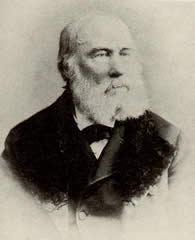This is an old revision of this page, as edited by Rotational (talk | contribs) at 16:07, 6 April 2009 (Reverted to version by Prodego). The present address (URL) is a permanent link to this revision, which may differ significantly from the current revision.
Revision as of 16:07, 6 April 2009 by Rotational (talk | contribs) (Reverted to version by Prodego)(diff) ← Previous revision | Latest revision (diff) | Newer revision → (diff)
Walter Hood Fitch (28 February 1817 – 1892) was a botanical illustrator, born in Glasgow, Scotland. Fitch executed some 10,000 drawings, for various publications, including 2700 for the Botanical Magazine.
Biography
Fitch was involved in fabric printing from the age of 17 and took to botanical art after being discovered by William Jackson Hooker, the editor of Curtis's Botanical Magazine. Hooker was Regius Professor of Botany at the University of Glasgow, and a competent botanical artist in his own right. Fitch's first lithograph of Mimulus roseus, appeared in the Botanical Magazine in 1834, and he soon became the sole artist for the magazine. In 1841, W.J. Hooker became director of Royal Botanic Gardens, Kew and Fitch moved to London. After 1841 Fitch was the sole artist for all official and unofficial publications issued by Kew; his work was paid for by Hooker personally. It was not unusual for him to work on several different publications simultaneously; he could draw directly onto the lithographic stone to save time. He produced his Chromolithographs, a then new technique, after the illustrations provided by Hooker and others.

Fitch's important works are his illustrations for William Hooker's A century of orchidaceous plants (1851), and for James Bateman's A Monograph of Odontoglossum (1864–74). He also created around 500 plates for Hooker's Icones Plantarum (1836–76). Some of his most notable work was for George Bentham and J.D. Hooker's Handbook of the British Flora (1858 and many editions). When Joseph Dalton Hooker returned from his travels in India, Fitch prepared lithographs from Hooker's sketches for his Rhododendrons of Sikkim Himalaya (1849–51) and, from the drawings of Indian artists, for his Illustrations of Himalayan Plants (1855). He also produced the illustrations presented in the younger Hooker's The Botany of the Antartic Voyage and Flora Tasmaniae 1855-9.
A dispute over pay with J. D. ended Fitch's service to both the Botanical Magazine and Kew in 1877. He was much sought after and remained active as a botanical artist until 1888. Works during this period included Henry John Elwes's Monograph of the Genus Lilium (1877-80). His renown as a botanical illustrator was such that his obituary in Nature stated "... his reputation was so high and so world-wide that it is unnecessary to say much on this point.". John Nugent Fitch (1840–1927), who also drew for Curtis's Botanical Magazine, was his nephew.
References
- Royal Botanic Gardens, Kew: website.
- ^ "Fitch, Walter Hood (1817 - 1892)". Collectors & Illustrators. Australian National Herbarium. Retrieved 2009-03-29.
- "Plants and Gardens portrayed". LuEsther T. Mertz Library. The New York Botanical Garden. Retrieved 2009-03-29.
- News. Nature 45, 302-302 (28 January 1892)
Further reading
- Walter Hood Fitch - A Celebration Royal Botanic Gardens, Kew, HMSO, London.